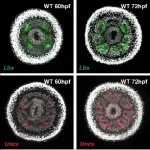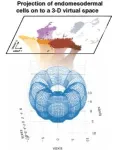(Press-News.org) KANSAS CITY, MO—June 13, 2023—Lacking bones, brains, and even a complete gut, the body plans of simple animals like sea anemones appear to have little in common with humans and their vertebrate kin. Nevertheless, new research from Investigator Matt Gibson, Ph.D., at the Stowers Institute for Medical Research shows that appearances can be deceiving, and that a common genetic toolkit can be deployed in different ways to drive embryological development to produce very different adult body plans.
It is well established that sea anemones, corals, and their jellyfish relatives shared a common ancestor with humans that plied the Earth’s ancient oceans over 600 million years ago. A new study from the Gibson Lab, published in Current Biology on June 13, 2023, illuminates the genetic basis for body plan development in the starlet sea anemone, Nematostella vectensis. This new knowledge paints a vivid picture of how some of the earliest animals on earth progressed from egg to embryo to adult.
“Studying the developmental genetics of Nematostella is sort of like taking a time machine into the very distant past,” said Gibson. “Our work allows us to ask what life looked like long ago— hundreds of millions of years before the dinosaurs. How did ancient animals develop from egg to adult, and to what extent have the genetic mechanisms that guide embryonic development endured across millennia?”
Most contemporary animals, from insects to vertebrates, develop by forming a head-to-tail series of segments that assume distinct identities depending on their position. Within a given segment, there is a further axis of polarity that informs cells whether they are at the front or back of the segment. Collectively, this is referred to as segment polarization.
Shuonan He, Ph.D., a former predoctoral researcher from the Gibson Lab, uncovered genes involved during development of the sea anemone, Nematostella vectensis, that guide the formation of segments and others that direct segment polarity programs strikingly similar to organisms higher up the evolutionary tree of life, including humans.
“The significance is that the genetic instructions underlying the construction of extremely different animal body plans, for example, a sea anemone and a human, are incredibly similar,” said Gibson. “The genetic logic is largely the same.”
This new study builds upon a 2018 study published in Science from the Gibson Lab that showed that sea anemones have an internal bilateral symmetry early in development with eight radial segments. The study demonstrated that Hox genes—master development genes that are crucial for human development—act to delineate boundaries between segments and likely had an ancient role in segment construction.
The team’s latest finding explores how segments form and what accounts for differences in their identities. Using spatial transcriptomics, or the differences in gene expression between segments, the team discovered hundreds of new segment-specific genes. These include two crucial genes that encode transcription factors that govern segment polarization under the control of Hox genes and are required for the proper placement of sea anemone muscles.
The astonishing diversity of organisms on Earth can be compared to the assembly of Legos. “Whether you construct a dinosaur, a sea anemone, or a human, many of the core genetic building blocks are largely the same despite drastically different animal forms,” said Gibson.
This is the first time that scientists have evidence of a molecular basis for segment polarization in a pre-bilaterian animal. While extensively studied in bilateral species like fruit flies and humans, the idea that cnidarian animals possess segmentation was unexpected. Now, the team has evidence that these segments are also polarized.
“This provides further evidence that investigating a broad diversity of animals can have direct implications for understanding general principles, including those which apply to human biology,” said Gibson. “Going one step further, by understanding the logic of sea anemone development and comparing it to what we see in vertebrates, we can also extrapolate back in time to understand how animals likely developed hundreds of millions of years ago.”
Additional authors include Wanqing Shao, Ph.D., Shiyuan Chen, Ph.D., and Ting Wang, Ph.D.
This work was funded by the National Institutes of Health (NIH) (award: RO1HG007175, award: U24ES026699, award: U01CA200060, award: U01HG009391, award: U41HG010972) and institutional support from the Stowers Institute for Medical Research. The content is solely the responsibility of the authors and does not necessarily represent the official views of the NIH.
About the Stowers Institute for Medical Research
Founded in 1994 through the generosity of Jim Stowers, founder of American Century Investments, and his wife, Virginia, the Stowers Institute for Medical Research is a non-profit, biomedical research organization with a focus on foundational research. Its mission is to expand our understanding of the secrets of life and improve life’s quality through innovative approaches to the causes, treatment, and prevention of diseases.
The Institute consists of 20 independent research programs. Of the approximately 500 members, over 370 are scientific staff that include principal investigators, technology center directors, postdoctoral scientists, graduate students, and technical support staff. Learn more about the Institute at www.stowers.org and about its graduate program at www.stowers.org/gradschool.
Media Contact:
Joe Chiodo, Head of Media Relations
724.462.8529
press@stowers.org
END
Stowers scientists investigate the evolution of animal developmental mechanisms, show how some of Earth’s earliest animals evolved
New knowledge paints a vivid picture of how some of the earliest animals on earth progressed from egg to embryo to adult
2023-06-13
ELSE PRESS RELEASES FROM THIS DATE:
Integrating offshore wind into China’s power grid can further carbon neutrality goals
2023-06-13
OFFSHORE WIND POWER OFFERS A PROMISING SOLUTION to the challenge of decarbonizing coastal China. China’s coastal provinces, though small in land mass, are home to 76% of the population; they are also responsible for 72% of total national power consumption and 70% of total CO2 emissions. Transitioning the coastal areas away from fossil fuels is one of China’s core challenges for achieving carbon neutrality by 2060, and offshore wind power may hold the key.
New research published in Nature Communications develops a bottom-up model to ...
First side-necked turtle ever discovered in UK
2023-06-13
The first side-necked turtle ever to be found in the UK has been discovered by an amateur fossil collector and palaeontologists at the University of Portsmouth.
The fossil remains are the earliest of a so-called side-necked pan-pleurodiran turtle, named as such because they fold their neck into their shell sideways when threatened. This does mean they can only see out with one eye.
Originally found on a National Trust beach on the Isle of Wight, the turtle fossil is an almost complete shell with cervical, dorsal and caudal vertebrae, scapulae, pelvic girdle and appendicular bones. Sadly, the skull was missing.
Lead author, Megan Jacobs, ...
Black patients with plaque build-up in arteries in the legs more likely to have a stroke, heart attack or amputation than white patients
2023-06-13
LOS ANGELES -- A new study from Keck Medicine of USC has uncovered significant racial disparities in the diagnosis, treatment and outcomes of peripheral artery disease (PAD) among Black and white patients in the United States.
PAD, which affects approximately eight to 12 million Americans and is associated with nearly half of the 150,000 yearly amputations in the U.S., is a potentially life-threatening condition in which the arteries that carry blood from the heart to the legs narrow or become blocked by the buildup of fatty plaque. This can lead to a heart attack, stroke or amputation of the affected limb.
“We discovered that Black patients are nearly 50% less ...
Estimating dementia risk using multifactorial prediction models
2023-06-13
About The Study: The findings of this study suggest that current dementia risk scores have limited clinical utility for estimation of 10-year dementia risk. Further research is needed to develop more accurate algorithms for estimation of dementia risk.
Authors: Mika Kivimäki, Ph.D. of University College London, is the corresponding author.
To access the embargoed study: Visit our For The Media website at this link https://media.jamanetwork.com/
(doi: 10.1001/jamanetworkopen.2023.18132)
Editor’s Note: Please see the article for ...
Content analysis of emoji and emoticon use in clinical texting systems
2023-06-13
About The Study: This study found that when clinicians use emoji and emoticons in secure clinical texting systems, these symbols function primarily to convey new and interactionally salient information. These results suggest that concerns about the professionalism of emoji and emoticon use may be unwarranted.
Authors: Colin M. E. Halverson, Ph.D., of the Indiana University School of Medicine in Indianapolis, is the corresponding author.
To access the embargoed study: Visit our For The Media website at this link https://media.jamanetwork.com/
(doi: 10.1001/jamanetworkopen.2023.18140)
Editor’s Note: Please ...
People who preserve ‘immune resilience’ live longer, resist infections
2023-06-13
Embargoed by Nature Communications until 10 a.m. Central Time on Tuesday, June 13
SAN ANTONIO (June 13, 2023) — Researchers from The University of Texas Health Science Center at San Antonio, working with collaborators in five countries, today revealed that the capacity to resist or recover from infections and other sources of inflammatory stress — called “immune resilience” — differs widely among individuals. The researchers developed a unique set of metrics to quantify the level ...
Improving potential stem cell-based treatments for patients with Type 1 Diabetes
2023-06-13
Following encouraging results from pre-clinical research and a recent clinical trial on stem cell-based treatments for patients with Type 1 diabetes, researchers are now working on maximizing the function and potential of stem cell-based treatments for future application in patients.
More than 8 billion people worldwide live with Type 1 diabetes (T1D) according to recent estimates. In T1D, the so-called beta cells in the pancreas do not make enough of the hormone insulin due to the destruction of beta-cells by the immune system leading to blood sugar levels rising above normal levels. Over time, T1D can lead to severe organ damage. There is no cure ...
Lung and heart stem cell research paves way for new COVID-19 treatments
2023-06-13
Researchers have used heart and lung stem cells infected with the virus that causes COVID-19 to better understand how the disease impacts different organs, paving the way for more targeted treatments.
The research, co-led by Murdoch Children’s Research Institute and the Peter Doherty Institute for Infection and Immunity (Doherty Institute), found the responses to SARS-CoV-2 varied significantly depending on the cell type, allowing the team to identify effective anti-viral drugs to treat infection in heart and lung cells. The findings were published in the 10th anniversary edition of Stem Cell Reports.
Murdoch ...
Four state policies linked to growth of telehealth at mental health facilities
2023-06-13
Four state policies introduced during the COVID-19 pandemic to spur expansion of telehealth were associated with expansion of such services by mental health facilities, but growth of telehealth was lower among facilities in counties with the greatest proportion of Black residents, according to a new RAND Corporation study.
Expansion of telehealth also was lower among facilities that accepted Medicaid or the Children’s Health Insurance Program, two government insurance programs that aid primarily lower-income Americans, according to the study.
The findings show that disparities in access to mental health care persisted even as ...
Only 1 in 4 adolescent treatment facilities offer buprenorphine for opioid use disorder
2023-06-13
Only 1 in 4 residential addiction treatment facilities caring for U.S. adolescents under 18 years old offer buprenorphine, a medication used to treat opioid use disorder, according to a new study. Only 1 in 8 offer buprenorphine for ongoing treatment. These findings highlight a significant gap in access to evidence-based addiction treatment among young people. Published in JAMA, this study was supported by the National Institute on Drug Abuse (NIDA) and the National Center for Advancing Translational Sciences ...
LAST 30 PRESS RELEASES:
New expert guidance urges caution before surgery for patients with treatment-resistant constipation
Solar hydrogen can now be produced efficiently without the scarce metal platinum
Sleeping in on weekends may help boost teens’ mental health
Study: Teens use cellphones for an hour a day at school
After more than two years of war, Palestinian children are hungry, denied education and “like the living dead”
The untold story of life with Prader-Willi syndrome - according to the siblings who live it
How the parasite that ‘gave up sex’ found more hosts – and why its victory won’t last
When is it time to jump? The boiling frog problem of AI use in physics education
Twitter data reveals partisan divide in understanding why pollen season's getting worse
AI is quick but risky for updating old software
Revolutionizing biosecurity: new multi-omics framework to transform invasive species management
From ancient herb to modern medicine: new review unveils the multi-targeted healing potential of Borago officinalis
Building a global scientific community: Biological Diversity Journal announces dual recruitment of Editorial Board and Youth Editorial Board members
Microbes that break down antibiotics help protect ecosystems under drug pollution
Smart biochar that remembers pollutants offers a new way to clean water and recycle biomass
Rice genes matter more than domestication in shaping plant microbiomes
Ticking time bomb: Some farmers report as many as 70 tick encounters over a 6-month period
Turning garden and crop waste into plastics
Scientists discover ‘platypus galaxies’ in the early universe
Seeing thyroid cancer in a new light: when AI meets label-free imaging in the operating room
Neutrophil-to-lymphocyte ratio may aid risk stratification in depressive disorder
2026 Seismological Society of America Annual Meeting
AI-powered ECG analysis offers promising path for early detection of chronic obstructive pulmonary disease, says Mount Sinai researchers
GIMM uncovers flaws in lab-grown heart cells and paves the way for improved treatments
Cracking the evolutionary code of sleep
Medications could help the aging brain cope with surgery, memory impairment
Back pain linked to worse sleep years later in men over 65, according to study
CDC urges ‘shared decision-making’ on some childhood vaccines; many unclear about what that means
New research finds that an ‘equal treatment’ approach to economic opportunity advertising can backfire
Researchers create shape-shifting, self-navigating microparticles
[Press-News.org] Stowers scientists investigate the evolution of animal developmental mechanisms, show how some of Earth’s earliest animals evolvedNew knowledge paints a vivid picture of how some of the earliest animals on earth progressed from egg to embryo to adult





